Notre-Dame-et-Saint-Privat Cathedral in Mende |
Located in the heart of the city of Mende in Lozère, the Cathedral of Notre-Dame-and-Saint-Privat is a major religious building whose history dates back to the 14th century. Its construction was initiated under the influence of Pope Urban V, a native of the region, who wanted to provide his hometown with a monument worthy of the name. Originally built in a southern Gothic style, it was partially destroyed during the Wars of Religion in the 16th century by the Protestant troops of Merle. Subsequently rebuilt, it retains remarkable elements from this period, such as the western façade and its two asymmetrical towers, one known as the "Bell Tower" and the other as the "Clock Tower." The interior notably houses an older Romanesque crypt as well as splendid organs. The cathedral thus reflects a rich architectural and spiritual past, remaining an essential point of interest for anyone visiting this region of France. It is classified as a historical monument.

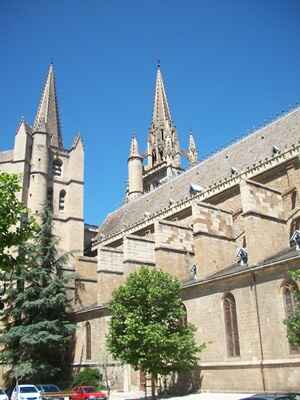 The Cathedral of Notre-Dame-and-Saint-Privat, in memory of the first bishop of Gévaudan, who was killed by the barbarians, has a long history. It replaced three other churches, built on the tomb of Saint Privat, at the foot of Mount Mimat. Pope Urban V, who was from the region, beautified it, but the Huguenots ravaged it. It became a minor basilica in 1874, and it attracts pilgrims. They come to see its 12th-century Black Virgin. It also has treasures of art, such as its organs, woodwork, tapestries, its high altar, and especially the clapper of the "Non-Pareille," the largest bell in the Christian world at that time.
The Cathedral of Notre-Dame-and-Saint-Privat, in memory of the first bishop of Gévaudan, who was killed by the barbarians, has a long history. It replaced three other churches, built on the tomb of Saint Privat, at the foot of Mount Mimat. Pope Urban V, who was from the region, beautified it, but the Huguenots ravaged it. It became a minor basilica in 1874, and it attracts pilgrims. They come to see its 12th-century Black Virgin. It also has treasures of art, such as its organs, woodwork, tapestries, its high altar, and especially the clapper of the "Non-Pareille," the largest bell in the Christian world at that time.
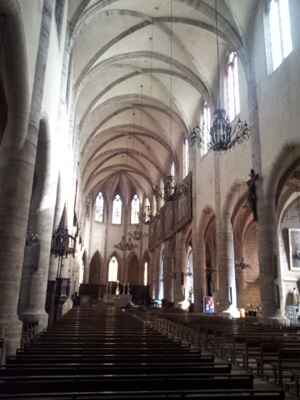 Mende, the capital of Gévaudan, has always had a church for its patron saint. In the 3rd century, the Alamanni, with Chrocus at their head, invaded the region. They frightened the inhabitants, who hid in a fort. Bishop Privat took refuge on a mountain. Chrocus caught him and tortured him, but he did not renounce his faith. Privat died a martyr, and the Alamanni left. Later, he became a great saint of Gaul. It was on his tomb that the first church of Mende was built, perhaps where the cathedral is today. Excavations have revealed a Carolingian church, transformed in the 10th century by a pre-Romanesque church, which was burned in a fire around 1100. Aldebert II de Peyre, bishop from 1109 to 1123, built the third, larger church.
Mende, the capital of Gévaudan, has always had a church for its patron saint. In the 3rd century, the Alamanni, with Chrocus at their head, invaded the region. They frightened the inhabitants, who hid in a fort. Bishop Privat took refuge on a mountain. Chrocus caught him and tortured him, but he did not renounce his faith. Privat died a martyr, and the Alamanni left. Later, he became a great saint of Gaul. It was on his tomb that the first church of Mende was built, perhaps where the cathedral is today. Excavations have revealed a Carolingian church, transformed in the 10th century by a pre-Romanesque church, which was burned in a fire around 1100. Aldebert II de Peyre, bishop from 1109 to 1123, built the third, larger church.
The cathedral was surrounded by the castles of the local lords. The Urbain-V square was Castel-Frag, the castle of the Counts of Barcelona. To the east, the castle of Canilhac overlooked the choir of the cathedral. The Cabrières castle was where the Chaptal square is now; that of Dolan was on the other side. The church was near the center of the fortified town, which was over 2,000 m around. In 1163, the cathedral saw Pope Alexander III, who was on his way to the Council of Tours. Bishop Aldebert III du Tournel, who had fortified the city, followed him to this council.
The Cathedral of Mende is a Gothic jewel, dominating the city with its tall spire. But it has known dark days before becoming so beautiful. Its history begins with a native child who was to change the fate of Mende. This child was Guillaume de Grimoard, son of noble peasants from Gévaudan. He loved faith and law, and he studied a lot. He became a monk, then a teacher, then pope under the name Urban V. He was a dreamer who wanted to reform the Church and bring peace to Europe. In 1364, he had a crazy idea: he wanted to rebuild the cathedral of Mende, which was in ruins. He asked the King of France to count all the households in Gévaudan and to give him a special tax to pay for the work. He chose his friend Pierre d'Aigrefeuille, bishop of Mende, and entrusted him with the task of making the cathedral a masterpiece of art and faith.
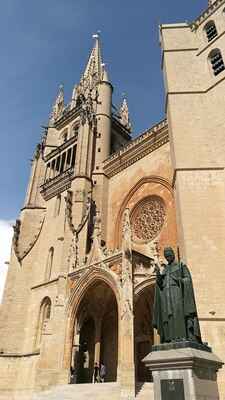 The work was progressing well when misfortune struck: a fire destroyed part of the cathedral. Urban V, from Rome, did not lose heart. He sent a letter to provide more money to the diocese of Mende. He took the place of Pierre d'Aigrefeuille, and he had it overseen by three vicars, who were to give all the income to the construction of the cathedral. He said, in the face of the disaster: "Praise be to God, who has allowed this trial and at the same time gives me the means to overcome it. We will rebuild it and we will do more good than the devil has done harm." He called Pierre Morel, a master builder from Mallorca, who had already worked at La Chaise-Dieu. The work continued to the east of the old Romanesque church, which was gradually demolished. But the death of Urban V in 1370 halted everything. The kingdom, in the Hundred Years' War, was experiencing a terrible crisis.
The work was progressing well when misfortune struck: a fire destroyed part of the cathedral. Urban V, from Rome, did not lose heart. He sent a letter to provide more money to the diocese of Mende. He took the place of Pierre d'Aigrefeuille, and he had it overseen by three vicars, who were to give all the income to the construction of the cathedral. He said, in the face of the disaster: "Praise be to God, who has allowed this trial and at the same time gives me the means to overcome it. We will rebuild it and we will do more good than the devil has done harm." He called Pierre Morel, a master builder from Mallorca, who had already worked at La Chaise-Dieu. The work continued to the east of the old Romanesque church, which was gradually demolished. But the death of Urban V in 1370 halted everything. The kingdom, in the Hundred Years' War, was experiencing a terrible crisis.
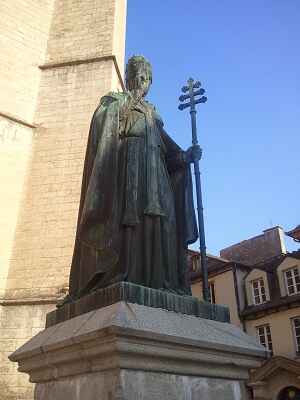 For sixty years, the cathedral remained unfinished: a half-built nave above the tomb of Saint Privat, a choir begun, all decorated with gifts from Urban V, who had also sent rare relics: a thorn from Christ's crown and the head of Saint Blaise in a silver chest. Among these gifts were: a golden statue of the Virgin, seated and crowned with pearls; two golden angels carried by six metal lions; a golden box; two gold paintings (one showing the Virgin Mary, the other Saint Veronica).
For sixty years, the cathedral remained unfinished: a half-built nave above the tomb of Saint Privat, a choir begun, all decorated with gifts from Urban V, who had also sent rare relics: a thorn from Christ's crown and the head of Saint Blaise in a silver chest. Among these gifts were: a golden statue of the Virgin, seated and crowned with pearls; two golden angels carried by six metal lions; a golden box; two gold paintings (one showing the Virgin Mary, the other Saint Veronica).
In addition to these beautiful objects offered by the pope, there were also items for the Mass and the procession, and tapestries (more than thirty according to the 1380 list). But the chapter, lacking money, wanted to sell part of this treasure to finish the cathedral. However, the treasure offered by the Holy See was sacred, and Cardinal Anglic de Grimoard, the brother of Urban V, came to Mende to prevent the chapter from committing this sin. In 1392, King Charles VI added the pope's threat by ordering the punishment of the canons who touched the treasure.
It was the canons of Mende who continued his dream in 1452. They built chapels around the choir to make it shine with a thousand lights. On September 7 of that year, Provost Guilhabert de Cénaret laid the first stone of these chapels, known as radiating chapels. The choir was consecrated in 1467 by Bishop Guy de La Panouse, who breathed his last the following year. His nephew and successor, Antoine de La Panouse, completed his work by installing sumptuous stained glass windows. These windows were made by Guillaume Papillon, a master glassmaker from Toulouse, in 1468. They tell stories of the life of Christ, the Virgin, and the saints. They are admired as jewels of Gothic art. By around 1470, the choir of the cathedral was completely finished.
The Cathedral of Mende has two bell towers that do not resemble each other. The one on the left, the taller, belongs to the bishop. The one on the right, the shorter, belongs to the canons. This difference comes from the rivalry between them. In 1508, the bishop of Mende was François de La Rovère, a relative of Pope Julius II, who had started the Basilica of St. Peter in Rome. François de La Rovère wanted to do the same in Mende and began to build a giant bell tower for the cathedral. He paid for it out of his own pocket, without consulting the canons. They, angry, began to make another tower, smaller but just as beautiful.The two towers were to be placed above pentagon-shaped chapels, at the back of the cathedral. But the ground was not strong enough to support them. So, they were placed at the front, in the buildings of the bishop's palace. The large tower was started on August 2, 1508, and the small tower on July 13, 1509. They were finished in 1512. The large tower is 84 meters high, and the small tower is 65 meters.
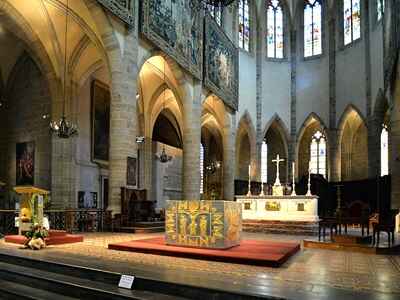 Bishop François de La Rovère wanted to place an extraordinary bell in his bell tower that would bring glory to Mende. He therefore commissioned the largest bell in the Christian world at that time, which he called Non-Pareille. It weighed 12,500 kg, with a diameter of 3.25 m, a height of 2.75 m, and a thickness of 33 cm. It came from Lyon, and its hammer from Gard. It arrived in Mende in 1516 after a difficult journey. It was placed in the large bell tower, where it rang for the hours and celebrations. It is said that it could be heard 16 km away.
Bishop François de La Rovère wanted to place an extraordinary bell in his bell tower that would bring glory to Mende. He therefore commissioned the largest bell in the Christian world at that time, which he called Non-Pareille. It weighed 12,500 kg, with a diameter of 3.25 m, a height of 2.75 m, and a thickness of 33 cm. It came from Lyon, and its hammer from Gard. It arrived in Mende in 1516 after a difficult journey. It was placed in the large bell tower, where it rang for the hours and celebrations. It is said that it could be heard 16 km away.
 The besieged cathedral In 1572, Baron Astorg de Peyre, a Catholic, was assassinated in Paris during the St. Bartholomew's Massacre. His wife called Matthieu Merle, a Protestant leader, to avenge her husband. Merle took several towns in Gévaudan, including Marvejols. He also wanted to take Mende, the capital. He took advantage of Christmas night in 1579, when people were at Mass, to enter the city with his men. Merle settled in the bishop's palace near the cathedral. He made the cathedral his fortress. He broke everything he found: statues, altars, organs, books, relics… He melted the bells and baptismal fonts to make cannons and bullets. The Non-Pareille, the largest bell in the world, was thrown into the Lot. Merle attacked the other towns of Gévaudan that opposed him, such as Balsièges, le Chastel-Nouvel, Ispagnac, Quézac, or Bédouès. He left Mende in 1581 after setting fire to the cathedral.
The besieged cathedral In 1572, Baron Astorg de Peyre, a Catholic, was assassinated in Paris during the St. Bartholomew's Massacre. His wife called Matthieu Merle, a Protestant leader, to avenge her husband. Merle took several towns in Gévaudan, including Marvejols. He also wanted to take Mende, the capital. He took advantage of Christmas night in 1579, when people were at Mass, to enter the city with his men. Merle settled in the bishop's palace near the cathedral. He made the cathedral his fortress. He broke everything he found: statues, altars, organs, books, relics… He melted the bells and baptismal fonts to make cannons and bullets. The Non-Pareille, the largest bell in the world, was thrown into the Lot. Merle attacked the other towns of Gévaudan that opposed him, such as Balsièges, le Chastel-Nouvel, Ispagnac, Quézac, or Bédouès. He left Mende in 1581 after setting fire to the cathedral.
The cathedral was rebuilt thanks to a new bishop, Adam de Heurtelou; it was rebuilt between 1599 and 1605. But it was no longer as pretty as before. It was made "without art or decoration," following the same plan as before. It was opened in 1605, but it was only consecrated in 1620 by Bishop Charles de Rousseau. It was at that time that it received new stained glass windows, including a large rose window. However, they were broken during the French Revolution in 1793.
 In 1605, the cathedral was also the scene of a crime that ended with the murder of a local lord: during a meeting of the nobles of Gévaudan, Baron de Randon, Armand de Polignac, and that of Apchier, Philibert, quarreled; Philibert, who had been the leader of the Catholics in Gévaudan, was killed a few days later, on January 18, during Mass. His murderer, Annet de Polignac, Baron of Villefort, was Armand's brother.
In 1605, the cathedral was also the scene of a crime that ended with the murder of a local lord: during a meeting of the nobles of Gévaudan, Baron de Randon, Armand de Polignac, and that of Apchier, Philibert, quarreled; Philibert, who had been the leader of the Catholics in Gévaudan, was killed a few days later, on January 18, during Mass. His murderer, Annet de Polignac, Baron of Villefort, was Armand's brother.
In 1692, Bishop François-Placide de Baudry de Piencourt offered the cathedral Aubusson tapestries depicting the New Testament. This bishop from Piencourt was a benefactor for the city of Mende. He took care of the sick and the poor by renovating the general hospital. When he died, he gave all his possessions to this hospital.
In 1732, lightning struck one of the four small towers of the large bell tower. Then, in 1784, it was the top of the large spire that was hit. Fortunately, the damage was quickly repaired in both cases.
 During the Revolution, there was a thought to use the small bell tower as a prison. But the project did not succeed. It was only at the beginning of the 19th century, under Napoleon, that the small bell tower served as a dungeon. Among the prisoners was the sub-prefect of Florac and even Marshal Soult.
During the Revolution, there was a thought to use the small bell tower as a prison. But the project did not succeed. It was only at the beginning of the 19th century, under Napoleon, that the small bell tower served as a dungeon. Among the prisoners was the sub-prefect of Florac and even Marshal Soult.
In 1825, a new altar, entirely made of white marble, was consecrated. The cathedral was part of the historical monuments of 1840 that required repairs. That year, the slates of the roof, which came from the area, were replaced with zinc plates. But the roof quickly deteriorated, and it had to be redone around 1880. It was at that time, under Bishop Julien Costes, that the south portal (on today's Chaptal square) was sculpted. You can see the coat of arms of this bishop above the tympanum.
A papal decree transformed the cathedral of Mende into a minor basilica in June 1874. This sacred place, founded by Urban V and having had Pope Julius II as bishop, thus received honors from the Holy See. In the forecourt, a statue of Urban V, sculpted by Dumont, was erected. Initially aligned with the main door, it was later installed in front of the small bell tower. The square now bore his name. The choir chapels, damaged by Merle, regained their former splendor, with their ribbed vaults.
At the end of the 19th century, Charles Laisné, a renowned architect, restored the stained glass and the rose window, with the help of the talented Émile Hirsch. The porch, which replaced the bell ringer's house, opened onto the Urbain-V square. A few years later, in 1906, the basilica-cathedral was recognized as a historical monument.
Former holiday hotel with a garden along the Allier, L'Etoile Guest House is located in La Bastide-Puylaurent between Lozere, Ardeche, and the Cevennes in the mountains of Southern France. At the crossroads of GR®7, GR®70 Stevenson Path, GR®72, GR®700 Regordane Way, GR®470 Allier River springs and gorges, GRP® Cevenol, Ardechoise Mountains, Margeride. Numerous loop trails for hiking and one-day biking excursions. Ideal for a relaxing and hiking getaway.
Copyright©etoile.fr